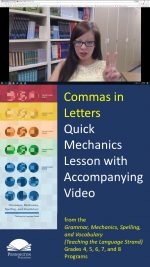Commas with Surname Titles
Commas with Surname Titles
Play the quick video lesson HERE and click the upper left back arrow to return to this lesson.
Common Core Language Standard 2
We use titles attached to our names for a variety of reasons. These titles indicate gender, family relationships, qualifications, licences, and educational degrees.
Now let’s read the mechanics lesson and study the examples.
Place a comma before and after any educational degrees and special qualifications which follow peoples’ last names. Educational degrees and special qualifications are often abbreviated. Examples: M.A. for Master of Arts, M.D. for Medical Doctor
Family titles that follow first names, such as Jr. for Junior or IV for the fourth family member with the same first name, are not set off by commas, but family titles that follow first and last names are set off by commas. Examples: John Jr. and Maurice Small, IV
Now circle or highlight what is right and revise what is wrong according to mechanics lesson.
Practice: Hiram Larkin, Sr. met with Hiram Jr., to discuss the hire of Kim Singh, M.A. English.
Let’s check the Practice Answers.
Mechanics Practice Answers: Hiram Larkin, Sr. met with Hiram Jr. to discuss the hire of Kim Singh, M.A. English.
Now let’s apply what we have learned.
Writing Application: Write your own sentences using a doctor’s title and a family title.
*****

Pennington Publishing Grammar Programs
Teaching Grammar, Usage, and Mechanics (Grades 4, 5, 6, 7, 8, and High School) are full-year, traditional, grade-level grammar, usage, and mechanics programs with plenty of remedial practice to help students catch up while they keep up with grade-level standards. Twice-per-week, 30-minute, no prep lessons in print or interactive Google slides with a fun secret agent theme. Simple sentence diagrams, mentor texts, video lessons, sentence dictations. Plenty of practice in the writing context. Includes biweekly tests and a final exam.
Grammar, Usage, and Mechanics Interactive Notebook (Grades 4‒8) is a full-year, no prep interactive notebook without all the mess. Twice-per-week, 30-minute, no prep grammar, usage, and mechanics lessons, formatted in Cornell Notes with cartoon response, writing application, 3D graphic organizers (easy cut and paste foldables), and great resource links. No need to create a teacher INB for student make-up work—it’s done for you! Plus, get remedial worksheets, biweekly tests, and a final exam.
Syntax in Reading and Writing is a function-based, sentence-level syntax program, designed to build reading comprehension and increase writing sophistication. The 18 parts of speech, phrases, and clauses lessons are each leveled from basic (elementary) to advanced (middle and high school) and feature 5 lesson components (10–15 minutes each): 1. Learn It! 2. Identify It! 3. Explain It! (analysis of challenging sentences) 4. Revise It! (kernel sentences, sentence expansion, syntactic manipulation) 5. Create It! (Short writing application with the syntactic focus in different genre).
Get the Diagnostic Grammar, Usage, and Mechanics Assessments, Matrix, and Final Exam FREE Resource:
![]()









